| Listing 1 - 10 of 51 | << page >> |
Sort by
|
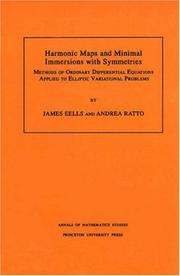
ISBN: 0691033218 069110249X 1400882508 9780691033211 9780691102498 Year: 1993 Volume: 130 Publisher: Princeton (N.J.): Princeton university press,
Abstract | Keywords | Export | Availability | Bookmark
 Loading...
Loading...Choose an application
- Reference Manager
- EndNote
- RefWorks (Direct export to RefWorks)
The aim of this book is to study harmonic maps, minimal and parallel mean curvature immersions in the presence of symmetry. In several instances, the latter permits reduction of the original elliptic variational problem to the qualitative study of certain ordinary differential equations: the authors' primary objective is to provide representative examples to illustrate these reduction methods and their associated analysis with geometric and topological applications. The material covered by the book displays a solid interplay involving geometry, analysis and topology: in particular, it includes a basic presentation of 1-cohomogeneous equivariant differential geometry and of the theory of harmonic maps between spheres.
Cartes harmoniques --- Harmonic maps --- Harmonische kaarten --- Immersies (Wiskunde) --- Immersions (Mathematics) --- Immersions (Mathématiques) --- Harmonic maps. --- Differential equations, Elliptic --- Applications harmoniques --- Immersions (Mathematiques) --- Équations différentielles elliptiques --- Numerical solutions. --- Solutions numériques --- Équations différentielles elliptiques --- Solutions numériques --- Differential equations [Elliptic] --- Numerical solutions --- Embeddings (Mathematics) --- Manifolds (Mathematics) --- Mappings (Mathematics) --- Maps, Harmonic --- Arc length. --- Catenary. --- Clifford algebra. --- Codimension. --- Coefficient. --- Compact space. --- Complex projective space. --- Connected sum. --- Constant curvature. --- Corollary. --- Covariant derivative. --- Curvature. --- Cylinder (geometry). --- Degeneracy (mathematics). --- Diagram (category theory). --- Differential equation. --- Differential geometry. --- Elliptic partial differential equation. --- Embedding. --- Energy functional. --- Equation. --- Existence theorem. --- Existential quantification. --- Fiber bundle. --- Gauss map. --- Geometry and topology. --- Geometry. --- Gravitational field. --- Harmonic map. --- Hyperbola. --- Hyperplane. --- Hypersphere. --- Hypersurface. --- Integer. --- Iterative method. --- Levi-Civita connection. --- Lie group. --- Mathematics. --- Maximum principle. --- Mean curvature. --- Normal (geometry). --- Numerical analysis. --- Open set. --- Ordinary differential equation. --- Parabola. --- Quadratic form. --- Sign (mathematics). --- Special case. --- Stiefel manifold. --- Submanifold. --- Suggestion. --- Surface of revolution. --- Symmetry. --- Tangent bundle. --- Theorem. --- Vector bundle. --- Vector space. --- Vertical tangent. --- Winding number. --- Differential equations, Elliptic - Numerical solutions
Book
ISBN: 0691615004 0691642575 1400856450 9781400856459 0691082901 9780691082905 9780691615004 9780691615004 9780691642574 Year: 2014 Publisher: Princeton, NJ : Princeton University Press,
Abstract | Keywords | Export | Availability | Bookmark
 Loading...
Loading...Choose an application
- Reference Manager
- EndNote
- RefWorks (Direct export to RefWorks)
Mathematical No/ex, 27Originally published in 1981.The Princeton Legacy Library uses the latest print-on-demand technology to again make available previously out-of-print books from the distinguished backlist of Princeton University Press. These editions preserve the original texts of these important books while presenting them in durable paperback and hardcover editions. The goal of the Princeton Legacy Library is to vastly increase access to the rich scholarly heritage found in the thousands of books published by Princeton University Press since its founding in 1905.
Riemannian manifolds. --- Minimal surfaces. --- Surfaces, Minimal --- Maxima and minima --- Manifolds, Riemannian --- Riemannian space --- Space, Riemannian --- Geometry, Differential --- Manifolds (Mathematics) --- Differential geometry. Global analysis --- Addition. --- Analytic function. --- Branch point. --- Calculation. --- Cartesian coordinate system. --- Closed geodesic. --- Codimension. --- Coefficient. --- Compactness theorem. --- Compass-and-straightedge construction. --- Continuous function. --- Corollary. --- Counterexample. --- Covering space. --- Curvature. --- Curve. --- Decomposition theorem. --- Derivative. --- Differentiable manifold. --- Differential geometry. --- Disjoint union. --- Equation. --- Essential singularity. --- Estimation. --- Euclidean space. --- Existence theorem. --- Existential quantification. --- First variation. --- Flat topology. --- Fundamental group. --- Geometric measure theory. --- Great circle. --- Homology (mathematics). --- Homotopy group. --- Homotopy. --- Hyperbolic function. --- Hypersurface. --- Integer. --- Line–line intersection. --- Manifold. --- Measure (mathematics). --- Minimal surface. --- Monograph. --- Natural number. --- Open set. --- Parameter. --- Partition of unity. --- Pointwise. --- Quantity. --- Regularity theorem. --- Riemann surface. --- Riemannian manifold. --- Scalar curvature. --- Scientific notation. --- Second fundamental form. --- Sectional curvature. --- Sequence. --- Sign (mathematics). --- Simply connected space. --- Smoothness. --- Sobolev inequality. --- Solid torus. --- Subgroup. --- Submanifold. --- Summation. --- Theorem. --- Topology. --- Two-dimensional space. --- Unit sphere. --- Upper and lower bounds. --- Varifold. --- Weak topology.
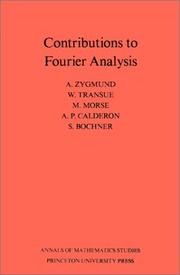
ISBN: 0691079307 1400881951 Year: 1950 Publisher: Princeton University Press
Abstract | Keywords | Export | Availability | Bookmark
 Loading...
Loading...Choose an application
- Reference Manager
- EndNote
- RefWorks (Direct export to RefWorks)
The description for this book, Contributions to Fourier Analysis. (AM-25), will be forthcoming.
Fourier analysis. --- Analysis, Fourier --- Mathematical analysis --- Absolute value. --- Almost periodic function. --- Approximation. --- Bessel function. --- Bilinear map. --- Boundary value problem. --- Characterization (mathematics). --- Coefficient. --- Compact space. --- Comparison theorem. --- Conservative vector field. --- Constant function. --- Continuous function. --- Corollary. --- Counterexample. --- Diagonalization. --- Diagram (category theory). --- Diameter. --- Dimension. --- Dirichlet kernel. --- Dirichlet problem. --- Dirichlet's principle. --- Distribution function. --- Exponential polynomial. --- Exponential sum. --- Fourier series. --- Fourier transform. --- Harmonic function. --- Hilbert space. --- Hölder's inequality. --- Integer. --- Interpolation theorem. --- Linear combination. --- Lp space. --- Measurable function. --- Measure (mathematics). --- Partial derivative. --- Partial differential equation. --- Periodic function. --- Poisson formula. --- Polynomial. --- Power series. --- Quantity. --- Rectangle. --- Remainder. --- Semicircle. --- Several complex variables. --- Sign (mathematics). --- Simple function. --- Special case. --- Sphere. --- Square root. --- Step function. --- Subsequence. --- Subset. --- Theorem. --- Theory. --- Triangle inequality. --- Two-dimensional space. --- Uniform continuity. --- Uniform convergence. --- Variable (mathematics). --- Vector field. --- Vector space.
Book
ISBN: 0691241538 Year: 2023 Publisher: Princeton, New Jersey ; Oxford : Princeton University Press,
Abstract | Keywords | Export | Availability | Bookmark
 Loading...
Loading...Choose an application
- Reference Manager
- EndNote
- RefWorks (Direct export to RefWorks)
The classic book that shares the enjoyment of mathematics with readers of all skill levelsWhat is so special about the number 30? Do the prime numbers go on forever? Are there more whole numbers than even numbers? The Enjoyment of Math explores these and other captivating problems and puzzles, introducing readers to some of the most fundamental ideas in mathematics. Written by two eminent mathematicians and requiring only a background in plane geometry and elementary algebra, this delightful book covers topics such as the theory of sets, the four-color problem, regular polyhedrons, Euler’s proof of the infinitude of prime numbers, and curves of constant breadth. Along the way, it discusses the history behind the problems, carefully explaining how each has arisen and, in some cases, how to resolve it. With an incisive foreword by Alex Kontorovich, this Princeton Science Library edition shares the enjoyment of math with a new generation of readers.
Mathematics --- Mathematical recreations. --- Mathematical puzzles --- Number games --- Recreational mathematics --- Recreations, Mathematical --- Puzzles --- Scientific recreations --- Games in mathematics education --- Magic squares --- Magic tricks in mathematics education --- Arbitrarily large. --- Arithmetic. --- Big O notation. --- Binomial theorem. --- Bonse's inequality. --- Circumference. --- Coefficient. --- Combination. --- Complete theory. --- Computation. --- Coprime integers. --- Diameter. --- Divisor. --- Equilateral triangle. --- Euler's formula. --- Euler's theorem. --- Exterior (topology). --- Factorial. --- Factorization. --- Fermat's Last Theorem. --- Fermat's theorem. --- Fourth power. --- Fractional part. --- Geometric mean. --- Geometric series. --- Geometry. --- Hypotenuse. --- Integer factorization. --- Intersection (set theory). --- Irrational number. --- Line segment. --- Logarithm. --- Long division. --- Mathematical induction. --- Mathematics. --- Metric space. --- Natural number. --- Non-Euclidean geometry. --- Number theory. --- Parallelogram. --- Parity (mathematics). --- Pedal triangle. --- Perfect number. --- Polyhedron. --- Power of 10. --- Prime factor. --- Prime number theorem. --- Prime number. --- Prime power. --- Pure mathematics. --- Pythagorean theorem. --- Rational number. --- Rectangle. --- Regular polygon. --- Regular polyhedron. --- Remainder. --- Reuleaux triangle. --- Rhomboid. --- Rhombus. --- Right angle. --- Right triangle. --- Scientific notation. --- Sign (mathematics). --- Special case. --- Straightedge. --- Summation. --- Theorem. --- Transfinite number. --- Variable (mathematics). --- Waring's problem.

ISBN: 069108081X 9781400822492 1400822491 9780691080819 Year: 1971 Volume: 66 Publisher: Princeton (N.J.) : Princeton university press,
Abstract | Keywords | Export | Availability | Bookmark
 Loading...
Loading...Choose an application
- Reference Manager
- EndNote
- RefWorks (Direct export to RefWorks)
Intended for researchers in Riemann surfaces, this volume summarizes a significant portion of the work done in the field during the years 1966 to 1971.
Riemann surfaces --- Mathematics --- Physical Sciences & Mathematics --- Calculus --- Surfaces, Riemann --- Functions --- Congresses --- Differential geometry. Global analysis --- RIEMANN SURFACES --- congresses --- Congresses. --- MATHEMATICS / Calculus. --- Affine space. --- Algebraic function field. --- Algebraic structure. --- Analytic continuation. --- Analytic function. --- Analytic set. --- Automorphic form. --- Automorphic function. --- Automorphism. --- Beltrami equation. --- Bernhard Riemann. --- Boundary (topology). --- Canonical basis. --- Cartesian product. --- Clifford's theorem. --- Cohomology. --- Commutative diagram. --- Commutative property. --- Complex multiplication. --- Conformal geometry. --- Conformal map. --- Coset. --- Degeneracy (mathematics). --- Diagram (category theory). --- Differential geometry of surfaces. --- Dimension (vector space). --- Dirichlet boundary condition. --- Eigenfunction. --- Eigenvalues and eigenvectors. --- Eisenstein series. --- Euclidean space. --- Existential quantification. --- Explicit formulae (L-function). --- Exterior (topology). --- Finsler manifold. --- Fourier series. --- Fuchsian group. --- Function (mathematics). --- Generating set of a group. --- Group (mathematics). --- Hilbert space. --- Holomorphic function. --- Homeomorphism. --- Homology (mathematics). --- Homotopy. --- Hyperbolic geometry. --- Hyperbolic group. --- Identity matrix. --- Infimum and supremum. --- Inner automorphism. --- Intersection (set theory). --- Intersection number (graph theory). --- Isometry. --- Isomorphism class. --- Isomorphism theorem. --- Kleinian group. --- Limit point. --- Limit set. --- Linear map. --- Lorentz group. --- Mapping class group. --- Mathematical induction. --- Mathematics. --- Matrix (mathematics). --- Matrix multiplication. --- Measure (mathematics). --- Meromorphic function. --- Metric space. --- Modular group. --- Möbius transformation. --- Number theory. --- Osgood curve. --- Parity (mathematics). --- Partial isometry. --- Poisson summation formula. --- Pole (complex analysis). --- Projective space. --- Quadratic differential. --- Quadratic form. --- Quasiconformal mapping. --- Quotient space (linear algebra). --- Quotient space (topology). --- Riemann mapping theorem. --- Riemann sphere. --- Riemann surface. --- Riemann zeta function. --- Scalar multiplication. --- Scientific notation. --- Selberg trace formula. --- Series expansion. --- Sign (mathematics). --- Square-integrable function. --- Subgroup. --- Teichmüller space. --- Theorem. --- Topological manifold. --- Topological space. --- Uniformization. --- Unit disk. --- Variable (mathematics). --- Riemann, Surfaces de --- RIEMANN SURFACES - congresses --- Fonctions d'une variable complexe --- Surfaces de riemann
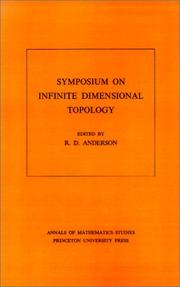
ISBN: 0691080879 1400881404 9780691080871 Year: 1972 Volume: 69 Publisher: Princeton (N.J.) : Princeton university press,
Abstract | Keywords | Export | Availability | Bookmark
 Loading...
Loading...Choose an application
- Reference Manager
- EndNote
- RefWorks (Direct export to RefWorks)
In essence the proceedings of the 1967 meeting in Baton Rouge, the volume offers significant papers in the topology of infinite dimensional linear spaces, fixed point theory in infinite dimensional spaces, infinite dimensional differential topology, and infinite dimensional pointset topology. Later results of the contributors underscore the basic soundness of this selection, which includes survey and expository papers, as well as reports of continuing research.
Topology --- Differential geometry. Global analysis --- Differential topology --- Functional analysis --- Congresses --- Analyse fonctionnnelle --- Geometry, Differential --- Anderson's theorem. --- Annihilator (ring theory). --- Automorphism. --- Baire measure. --- Banach algebra. --- Banach manifold. --- Banach space. --- Bounded operator. --- Cartesian product. --- Characterization (mathematics). --- Cohomology. --- Compact space. --- Complement (set theory). --- Complete metric space. --- Connected space. --- Continuous function. --- Convex set. --- Coset. --- Critical point (mathematics). --- Diagram (category theory). --- Differentiable manifold. --- Differential topology. --- Dimension (vector space). --- Dimension. --- Dimensional analysis. --- Dual space. --- Duality (mathematics). --- Endomorphism. --- Equivalence class. --- Euclidean space. --- Existential quantification. --- Explicit formulae (L-function). --- Exponential map (Riemannian geometry). --- Fixed-point theorem. --- Fréchet derivative. --- Fréchet space. --- Fuchsian group. --- Function space. --- Fundamental class. --- Haar measure. --- Hessian matrix. --- Hilbert space. --- Homeomorphism. --- Homology (mathematics). --- Homotopy group. --- Homotopy. --- Inclusion map. --- Infimum and supremum. --- Lebesgue space. --- Lefschetz fixed-point theorem. --- Limit point. --- Linear space (geometry). --- Locally convex topological vector space. --- Loop space. --- Mathematical optimization. --- Measure (mathematics). --- Metric space. --- Module (mathematics). --- Natural topology. --- Neighbourhood (mathematics). --- Normal space. --- Normed vector space. --- Open set. --- Ordinal number. --- Paracompact space. --- Partition of unity. --- Path space. --- Product topology. --- Quantifier (logic). --- Quotient space (linear algebra). --- Quotient space (topology). --- Radon measure. --- Reflexive space. --- Representation theorem. --- Riemannian manifold. --- Schauder fixed point theorem. --- Sign (mathematics). --- Simply connected space. --- Space form. --- Special case. --- Stiefel manifold. --- Strong operator topology. --- Subcategory. --- Submanifold. --- Subset. --- Tangent space. --- Teichmüller space. --- Theorem. --- Topological space. --- Topological vector space. --- Topology. --- Transfinite induction. --- Transfinite. --- Transversal (geometry). --- Transversality theorem. --- Tychonoff cube. --- Union (set theory). --- Unit sphere. --- Weak topology. --- Weakly compact. --- Differential topology - Congresses --- Functional analysis - Congresses --- Topology - Congresses --- Analyse fonctionnelle.
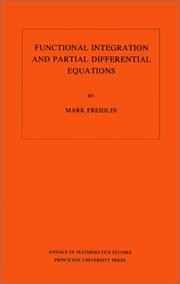
ISBN: 0691083541 1400881595 Year: 1985 Publisher: Princeton, N.J.
Abstract | Keywords | Export | Availability | Bookmark
 Loading...
Loading...Choose an application
- Reference Manager
- EndNote
- RefWorks (Direct export to RefWorks)
This book discusses some aspects of the theory of partial differential equations from the viewpoint of probability theory. It is intended not only for specialists in partial differential equations or probability theory but also for specialists in asymptotic methods and in functional analysis. It is also of interest to physicists who use functional integrals in their research. The work contains results that have not previously appeared in book form, including research contributions of the author.
Partial differential equations --- Differential equations, Partial. --- Probabilities. --- Integration, Functional. --- Functional integration --- Functional analysis --- Integrals, Generalized --- Probability --- Statistical inference --- Combinations --- Mathematics --- Chance --- Least squares --- Mathematical statistics --- Risk --- A priori estimate. --- Absolute continuity. --- Almost surely. --- Analytic continuation. --- Axiom. --- Big O notation. --- Boundary (topology). --- Boundary value problem. --- Bounded function. --- Calculation. --- Cauchy problem. --- Central limit theorem. --- Characteristic function (probability theory). --- Chebyshev's inequality. --- Coefficient. --- Comparison theorem. --- Continuous function (set theory). --- Continuous function. --- Convergence of random variables. --- Cylinder set. --- Degeneracy (mathematics). --- Derivative. --- Differential equation. --- Differential operator. --- Diffusion equation. --- Diffusion process. --- Dimension (vector space). --- Direct method in the calculus of variations. --- Dirichlet boundary condition. --- Dirichlet problem. --- Eigenfunction. --- Eigenvalues and eigenvectors. --- Elliptic operator. --- Elliptic partial differential equation. --- Equation. --- Existence theorem. --- Exponential function. --- Feynman–Kac formula. --- Fokker–Planck equation. --- Function space. --- Functional analysis. --- Fundamental solution. --- Gaussian measure. --- Girsanov theorem. --- Hessian matrix. --- Hölder condition. --- Independence (probability theory). --- Integral curve. --- Integral equation. --- Invariant measure. --- Iterated logarithm. --- Itô's lemma. --- Joint probability distribution. --- Laplace operator. --- Laplace's equation. --- Lebesgue measure. --- Limit (mathematics). --- Limit cycle. --- Limit point. --- Linear differential equation. --- Linear map. --- Lipschitz continuity. --- Markov chain. --- Markov process. --- Markov property. --- Maximum principle. --- Mean value theorem. --- Measure (mathematics). --- Modulus of continuity. --- Moment (mathematics). --- Monotonic function. --- Navier–Stokes equations. --- Nonlinear system. --- Ordinary differential equation. --- Parameter. --- Partial differential equation. --- Periodic function. --- Poisson kernel. --- Probabilistic method. --- Probability space. --- Probability theory. --- Probability. --- Random function. --- Regularization (mathematics). --- Schrödinger equation. --- Self-adjoint operator. --- Sign (mathematics). --- Simultaneous equations. --- Smoothness. --- State-space representation. --- Stochastic calculus. --- Stochastic differential equation. --- Stochastic. --- Support (mathematics). --- Theorem. --- Theory. --- Uniqueness theorem. --- Variable (mathematics). --- Weak convergence (Hilbert space). --- Wiener process.
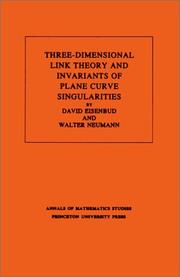
ISBN: 0691083819 0691083800 1400881927 9780691083810 9780691083803 Year: 1985 Volume: 110 Publisher: Princeton (N.J.): Princeton university press,
Abstract | Keywords | Export | Availability | Bookmark
 Loading...
Loading...Choose an application
- Reference Manager
- EndNote
- RefWorks (Direct export to RefWorks)
This book gives a new foundation for the theory of links in 3-space modeled on the modern developmentby Jaco, Shalen, Johannson, Thurston et al. of the theory of 3-manifolds. The basic construction is a method of obtaining any link by "splicing" links of the simplest kinds, namely those whose exteriors are Seifert fibered or hyperbolic. This approach to link theory is particularly attractive since most invariants of links are additive under splicing.Specially distinguished from this viewpoint is the class of links, none of whose splice components is hyperbolic. It includes all links constructed by cabling and connected sums, in particular all links of singularities of complex plane curves. One of the main contributions of this monograph is the calculation of invariants of these classes of links, such as the Alexander polynomials, monodromy, and Seifert forms.
Algebraic geometry --- Differential geometry. Global analysis --- Link theory. --- Curves, Plane. --- SINGULARITIES (Mathematics) --- Curves, Plane --- Invariants --- Link theory --- Singularities (Mathematics) --- Geometry, Algebraic --- Low-dimensional topology --- Piecewise linear topology --- Higher plane curves --- Plane curves --- Invariants. --- 3-sphere. --- Alexander Grothendieck. --- Alexander polynomial. --- Algebraic curve. --- Algebraic equation. --- Algebraic geometry. --- Algebraic surface. --- Algorithm. --- Ambient space. --- Analytic function. --- Approximation. --- Big O notation. --- Call graph. --- Cartesian coordinate system. --- Characteristic polynomial. --- Closed-form expression. --- Cohomology. --- Computation. --- Conjecture. --- Connected sum. --- Contradiction. --- Coprime integers. --- Corollary. --- Curve. --- Cyclic group. --- Determinant. --- Diagram (category theory). --- Diffeomorphism. --- Dimension. --- Disjoint union. --- Eigenvalues and eigenvectors. --- Equation. --- Equivalence class. --- Euler number. --- Existential quantification. --- Exterior (topology). --- Fiber bundle. --- Fibration. --- Foliation. --- Fundamental group. --- Geometry. --- Graph (discrete mathematics). --- Ground field. --- Homeomorphism. --- Homology sphere. --- Identity matrix. --- Integer matrix. --- Intersection form (4-manifold). --- Isolated point. --- Isolated singularity. --- Jordan normal form. --- Knot theory. --- Mathematical induction. --- Monodromy matrix. --- Monodromy. --- N-sphere. --- Natural transformation. --- Newton polygon. --- Newton's method. --- Normal (geometry). --- Notation. --- Pairwise. --- Parametrization. --- Plane curve. --- Polynomial. --- Power series. --- Projective plane. --- Puiseux series. --- Quantity. --- Rational function. --- Resolution of singularities. --- Riemann sphere. --- Riemann surface. --- Root of unity. --- Scientific notation. --- Seifert surface. --- Set (mathematics). --- Sign (mathematics). --- Solid torus. --- Special case. --- Stereographic projection. --- Submanifold. --- Summation. --- Theorem. --- Three-dimensional space (mathematics). --- Topology. --- Torus knot. --- Torus. --- Tubular neighborhood. --- Unit circle. --- Unit vector. --- Unknot. --- Variable (mathematics).

ISBN: 0691000492 0691033323 1400882524 Year: 1993 Publisher: Princeton, N.J. Princeton University Press
Abstract | Keywords | Export | Availability | Bookmark
 Loading...
Loading...Choose an application
- Reference Manager
- EndNote
- RefWorks (Direct export to RefWorks)
Toric varieties are algebraic varieties arising from elementary geometric and combinatorial objects such as convex polytopes in Euclidean space with vertices on lattice points. Since many algebraic geometry notions such as singularities, birational maps, cycles, homology, intersection theory, and Riemann-Roch translate into simple facts about polytopes, toric varieties provide a marvelous source of examples in algebraic geometry. In the other direction, general facts from algebraic geometry have implications for such polytopes, such as to the problem of the number of lattice points they contain. In spite of the fact that toric varieties are very special in the spectrum of all algebraic varieties, they provide a remarkably useful testing ground for general theories.The aim of this mini-course is to develop the foundations of the study of toric varieties, with examples, and describe some of these relations and applications. The text concludes with Stanley's theorem characterizing the numbers of simplicies in each dimension in a convex simplicial polytope. Although some general theorems are quoted without proof, the concrete interpretations via simplicial geometry should make the text accessible to beginners in algebraic geometry.
Algebraic geometry --- Differential geometry. Global analysis --- 512.7 --- Algebraic geometry. Commutative rings and algebras --- Toric varieties. --- 512.7 Algebraic geometry. Commutative rings and algebras --- Toric varieties --- Embeddings, Torus --- Torus embeddings --- Varieties, Toric --- Algebraic varieties --- Addition. --- Affine plane. --- Affine space. --- Affine variety. --- Alexander Grothendieck. --- Alexander duality. --- Algebraic curve. --- Algebraic group. --- Atiyah–Singer index theorem. --- Automorphism. --- Betti number. --- Big O notation. --- Characteristic class. --- Chern class. --- Chow group. --- Codimension. --- Cohomology. --- Combinatorics. --- Commutative property. --- Complete intersection. --- Convex polytope. --- Convex set. --- Coprime integers. --- Cotangent space. --- Dedekind sum. --- Dimension (vector space). --- Dimension. --- Direct proof. --- Discrete valuation ring. --- Discrete valuation. --- Disjoint union. --- Divisor (algebraic geometry). --- Divisor. --- Dual basis. --- Dual space. --- Equation. --- Equivalence class. --- Equivariant K-theory. --- Euler characteristic. --- Exact sequence. --- Explicit formula. --- Facet (geometry). --- Fundamental group. --- Graded ring. --- Grassmannian. --- H-vector. --- Hirzebruch surface. --- Hodge theory. --- Homogeneous coordinates. --- Homomorphism. --- Hypersurface. --- Intersection theory. --- Invertible matrix. --- Invertible sheaf. --- Isoperimetric inequality. --- Lattice (group). --- Leray spectral sequence. --- Limit point. --- Line bundle. --- Line segment. --- Linear subspace. --- Local ring. --- Mathematical induction. --- Mixed volume. --- Moduli space. --- Moment map. --- Monotonic function. --- Natural number. --- Newton polygon. --- Open set. --- Picard group. --- Pick's theorem. --- Polytope. --- Projective space. --- Quadric. --- Quotient space (topology). --- Regular sequence. --- Relative interior. --- Resolution of singularities. --- Restriction (mathematics). --- Resultant. --- Riemann–Roch theorem. --- Serre duality. --- Sign (mathematics). --- Simplex. --- Simplicial complex. --- Simultaneous equations. --- Spectral sequence. --- Subgroup. --- Subset. --- Summation. --- Surjective function. --- Tangent bundle. --- Theorem. --- Topology. --- Toric variety. --- Unit disk. --- Vector space. --- Weil conjecture. --- Zariski topology.
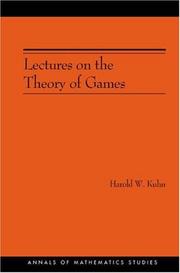
ISBN: 0691027714 0691027722 9786612159114 1282159119 1400829569 9781400829569 9781282159112 6612159111 9780691027715 9780691027722 Year: 2003 Volume: 37 Publisher: Princeton, N.J. : Princeton University Press,
Abstract | Keywords | Export | Availability | Bookmark
 Loading...
Loading...Choose an application
- Reference Manager
- EndNote
- RefWorks (Direct export to RefWorks)
This book is a spectacular introduction to the modern mathematical discipline known as the Theory of Games. Harold Kuhn first presented these lectures at Princeton University in 1952. They succinctly convey the essence of the theory, in part through the prism of the most exciting developments at its frontiers half a century ago. Kuhn devotes considerable space to topics that, while not strictly the subject matter of game theory, are firmly bound to it. These are taken mainly from the geometry of convex sets and the theory of probability distributions. The book opens by addressing "matrix games," a name first introduced in these lectures as an abbreviation for two-person, zero-sum games in normal form with a finite number of pure strategies. It continues with a treatment of games in extensive form, using a model introduced by the author in 1950 that quickly supplanted von Neumann and Morgenstern's cumbersome approach. A final section deals with games that have an infinite number of pure strategies for the two players. Throughout, the theory is generously illustrated with examples, and exercises test the reader's understanding. A historical note caps off each chapter. For readers familiar with the calculus and with elementary matrix theory or vector analysis, this book offers an indispensable store of vital insights on a subject whose importance has only grown with the years.
Operational research. Game theory --- Game theory --- 519.83 --- Theory of games --- 519.83 Theory of games --- Game theory. --- Games, Theory of --- Mathematical models --- Mathematics --- Abstract algebra. --- Addition. --- Algorithm. --- Almost surely. --- Analytic geometry. --- Axiom. --- Basic solution (linear programming). --- Big O notation. --- Bijection. --- Binary relation. --- Boundary (topology). --- Bounded set (topological vector space). --- Branch point. --- Calculation. --- Cardinality of the continuum. --- Cardinality. --- Cartesian coordinate system. --- Characteristic function (probability theory). --- Combination. --- Computation. --- Connectivity (graph theory). --- Constructive proof. --- Convex combination. --- Convex function. --- Convex hull. --- Convex set. --- Coordinate system. --- David Gale. --- Diagram (category theory). --- Differential equation. --- Dimension (vector space). --- Dimensional analysis. --- Disjoint sets. --- Distribution function. --- Embedding. --- Empty set. --- Enumeration. --- Equation. --- Equilibrium point. --- Equivalence relation. --- Estimation. --- Euclidean space. --- Existential quantification. --- Expected loss. --- Extreme point. --- Formal scheme. --- Fundamental theorem. --- Galois theory. --- Geometry. --- Hyperplane. --- Inequality (mathematics). --- Infimum and supremum. --- Integer. --- Iterative method. --- Line segment. --- Linear equation. --- Linear inequality. --- Matching Pennies. --- Mathematical induction. --- Mathematical optimization. --- Mathematical theory. --- Mathematician. --- Mathematics. --- Matrix (mathematics). --- Measure (mathematics). --- Min-max theorem. --- Minimum distance. --- Mutual exclusivity. --- Prediction. --- Probability distribution. --- Probability interpretations. --- Probability measure. --- Probability theory. --- Probability. --- Proof by contradiction. --- Quantity. --- Rank (linear algebra). --- Rational number. --- Real number. --- Requirement. --- Scientific notation. --- Sign (mathematics). --- Solution set. --- Special case. --- Statistics. --- Strategist. --- Strategy (game theory). --- Subset. --- Theorem. --- Theory of Games and Economic Behavior. --- Theory. --- Three-dimensional space (mathematics). --- Total order. --- Two-dimensional space. --- Union (set theory). --- Unit interval. --- Unit square. --- Vector Analysis. --- Vector calculus. --- Vector space.
| Listing 1 - 10 of 51 | << page >> |
Sort by
|

 Search
Search Feedback
Feedback About UniCat
About UniCat  Help
Help News
News